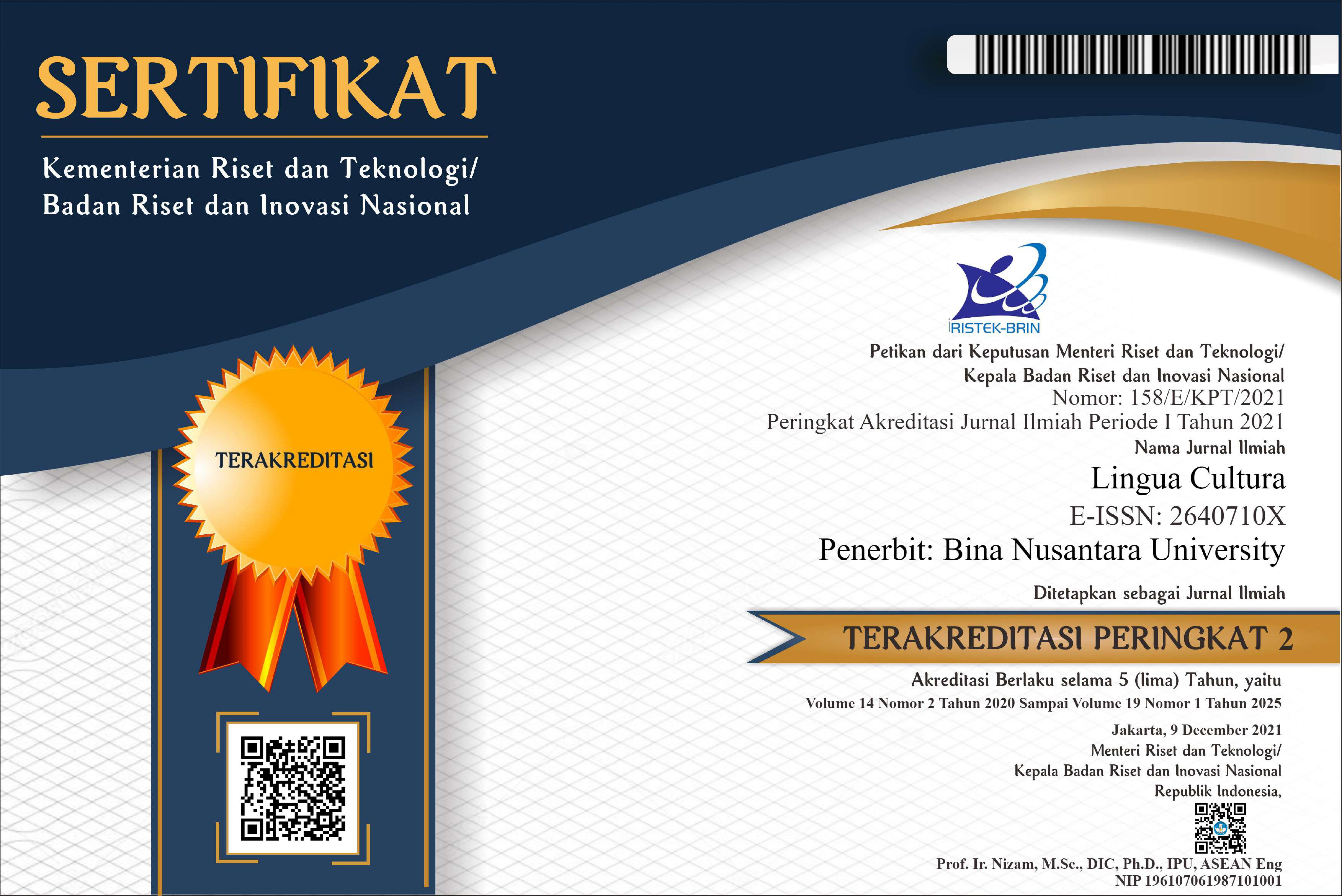Needs Analysis of the Important Communicative Features at De La Salle University
DOI:
https://doi.org/10.21512/lc.v2i1.244Keywords:
communication, linguistic, communicative competence, communicative featuresAbstract
Article analyzed the needs of communicative competence and gather information on the features of communicative competence that are believed to be important by selected foreign graduate students studying at DLSU. The features consist of linguistic, sociolinguistic, discourse, strategic, and intercultural competences. Data were obtained by giving questionnaire to 33 foreign students, consisting of 11 male and 22 females and were analyzed qualitatively. The findings suggest that all features of communicative competence are crucial. In addition, the linguistic competence and strategic competence are considered to be the most essential features of the communicative competence. It can be concluded that the foreign graduate students learn English to achieve their communicative competence and it is used to communicate among students.
Plum Analytics
References
Byram, M. and Fleming, M. 1998. Culture and language learning. In M. Byram and M. Fleming (Eds.), Language learning in intercultural perspective: Approaches through drama and ethnography. Cambridge: Cambridge University Press.
Canale, M. and Swain, M. 1983. Approaches to communicative competence. Singapore: Seameo Regional Language Centre.
Cortazzi, M. and Jin, L. 1999. Cultural mirrors. In E. Hinkel (Ed.). Cultural in second language teaching and learning. Cambridge: Cambridge University Press.
Crystal, D. 1997. English as a global language. Cambridge: Cambridge University Press.
Fatt, J. P. T. July, 1991. Achieving communicative competence: The role of higher education. Higher Education, 22 (1), 43-62. Retrieved April 10, 2007 from http://www.springerlink.com/content/770637571503nn81/
Friedrich, P. 2003. English in Argentina: Attitude of MBA students. World Englishes, 22(2), 173-184.
Intemann, F. 2006. Introducation to foreign language pedagogy. Retrieved February 20, 2007 from http://www.anglistik.tu-bs.de/esud/intro-flp/session03%20part1_WS0607.pdf
Intemann, F. 2006. Introducation to foreign language pedagogy. Retrieved February 20, 2007 from http://www.anglistik.tu-bs.de/esud/intro-flp/session03%20part1_WS0607.pdf
Irving, K.J. 1984. Theory into practice. Multicultural Education, 23(2), pp.138-143. Retrieved January 23, 2007 from http://links.jstor.org/sici=0044-5841%28198421%2923%3A2%3C138%3ACAATEC%3E2.0.CO%3B2-E.
Kirkpatrick, A. 2000. English as an Asian language. Retrieved February 20, 2007 from http://www.macmillaneducation.com/Globaldebate/asia.htm
Kirkpatrick, A. and Xu, Z. 2002. Chinese pragmatic norms and “China English.”. World Englishes, 21(2), 269–279.
Kramsch, C. 1998. The privilege of the intercultural speaker. In M. Byram and M. Fleming (Eds.). Language learning in intercultural perspective: Approaches through drama and ethnography. Cambridge : Cambridge University Press.
Littlewood, W. 1984. Foreign and second language learning. Melbourne, Australia: Cambridge University Press.
Mariani, L. June, 1994. Developing strategic competence: Towards autonomy in oral interaction. Perspectives, 20 (1) 1-22. Retrieved February 24, 2007 from file:///C:/Documents%20and%20Settings/NEC/My%20Documents/academic%20writing/strategic%20competence.htm
Mora, J.K. 2006. Communicative competence. Retrieved January 23, 2007 from http://coe.sdsu.edu/people/jmora/NatApprTheory-Eng/sld003.html.
Nunn, R. September, 2005. Competence and teaching English as an international language. Asian EFL Journal, 7 (3) 1-15. Retrieved February 24, 2007 from http://asian-efl-journal.com/sept_05_rn.pdf
Savignon, S. J. 1983. Communicative competence: Theory and classroom practice. MA: Addison- Wesley Publishing Company, Inc.
Downloads
Published
Issue
Section
License
Authors who publish with this journal agree to the following terms:
a. Authors retain copyright and grant the journal right of first publication with the work simultaneously licensed under a Creative Commons Attribution License - Share Alike that allows others to share the work with an acknowledgment of the work's authorship and initial publication in this journal.
b. Authors are able to enter into separate, additional contractual arrangements for the non-exclusive distribution of the journal's published version of the work (e.g., post it to an institutional repository or publish it in a book), with an acknowledgment of its initial publication in this journal.
c. Authors are permitted and encouraged to post their work online (e.g., in institutional repositories or on their website) prior to and during the submission process, as it can lead to productive exchanges, as well as earlier and greater citation of published work.
USER RIGHTS
All articles published Open Access will be immediately and permanently free for everyone to read and download. We are continuously working with our author communities to select the best choice of license options, currently being defined for this journal as follows: Creative Commons Attribution-Share Alike (CC BY-SA)

















